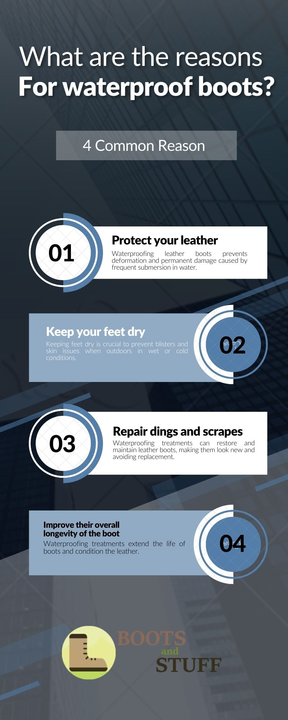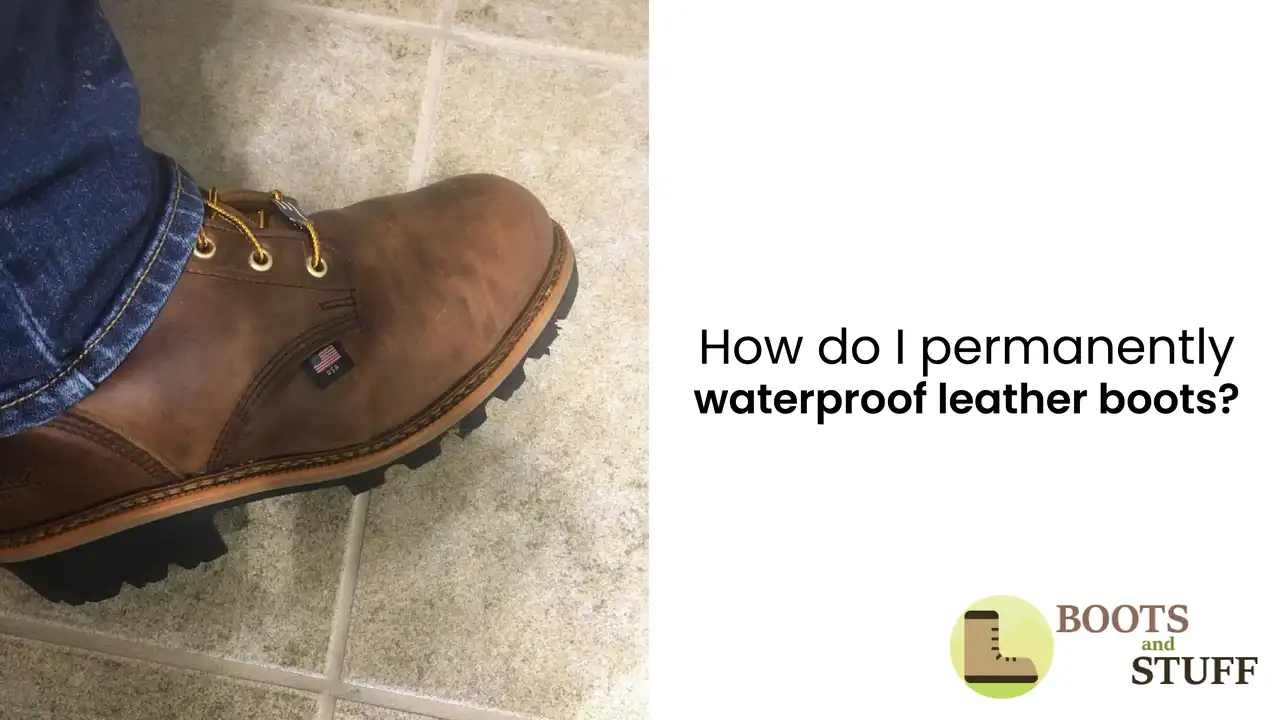Leather boots are a popular footwear choice due to their durability, comfort, and classic look. However, one crucial aspect of maintaining their longevity and performance is ensuring they are properly waterproofed. Failure to do so can lead to a variety of negative consequences, including decreased durability and an increased risk of fungal or bacterial infections.
In this article, we will explore the importance of waterproofing leather boots and provide tips on how to permanently waterproof leather boots. Let’s dig in.
Contents
Importance of waterproofing Leather Boots
Leather is a porous material, which means it contains small openings or spaces that allow air and water to pass through. When water enters these openings, it can be absorbed by the leather, causing it to become saturated and lose its structural integrity. This can lead to a number of issues, including stretching, cracking, and discoloration. Additionally, when leather absorbs water and then dries out, it can become stiff and uncomfortable to wear. Therefore, it’s important to properly waterproof your leather boots to prevent these problems and ensure their longevity.
Waterproofing is an essential step in protecting your leather boots from the elements. Leather boots are prone to damage from water, which can cause the leather to weaken and become discolored over time. Additionally, wet leather boots can be uncomfortable to wear and may even cause blisters or other foot problems. By waterproofing your leather boots, you can help to extend their lifespan, keep them looking new, and ensure that your feet stay dry and comfortable no matter what the weather conditions are. In this guide, we’ll discuss some of the best ways to waterproof your leather boots and keep them in great condition for years to come.
Is your leather boots waterproof?

Knowing whether or not you purchased waterproof leather boots is crucial before taking any action. Because if you already have one, then there is no necessity to do the waterproofing method.
Leather isn’t thought of as a waterproof material in and of itself. While leather has some built-in water resistance, it doesn’t combine well with water. However, pure animal leather is a porous material that cannot be completely waterproof if it gets into contact with water. Leather absorbs moisture if exposed to too much water due to its porous nature.
It’s crucial to keep in mind that the majority of waterproofing solutions are only effective temporarily.
Note: Most waterproofing solutions create a surface barrier that wears off over time, allowing water to penetrate the leather. Exposure to sunlight, heat, abrasion, and using low-quality products can contribute to the breakdown of the treatment. Proper application and regular maintenance can help extend the life of the waterproofing treatment.
When is the best time to waterproof leather boots?
If you want to waterproof your new boots, consider the right time to do that. It is the first step of the waterproofing process. If you choose the wrong time, the waterproofing treatment won’t work at its best.
As soon as the water stops producing droplets on the exterior of your leather boots, you should waterproof them.
When considering the best time to waterproof your leather boots, it’s important to choose a time when the weather is favorable.
In this context, favorable weather refers to dry conditions or weather with low humidity. This is because applying waterproofing agents during wet or humid weather can result in poor absorption and reduced effectiveness. It’s best to wait for a dry day before waterproofing your boots to ensure optimal results
Generally speaking, it’s better to waterproof them throughout the monsoon season than to let them soak up water as your feet get wet. If you notice that your boots have unusually high dirt and debris attached to them, you should also waterproof them.
What are the reasons for waterproof boots?
There are plenty of reasons to make your leather boots waterproof. It is essential to have waterproof work boots to get the best deal out of them. To ensure your boots are clean, healthy looking, and long-lasting, you will need to use the product for waterproofing boots.
1. Protect your leather
The first thing is protecting your leather boots. Yet if the boots get submerged in water frequently, the leather may deform in undesirable and permanent damage. Waterproofing ensures the leather does not absorb too much water, preventing total damage to your boots.
2. Keep your feet dry
Making the boots waterproof is the only reason to keep the feet dry. Due to the persistent moisture in the boots, your feet are more likely to develop blisters or other skin conditions. Keep your feet dry to protect your health when spending much time outside in icy or soggy conditions.
3. Repair dings and scrapes
Leather can get restored and maintained using waterproofing treatments (see below). They restore rips and dents in leather through treatment, making it look as good as new. You can also avoid purchasing new boots by doing it this way. It’s the most affordable and simple to maintain and waterproof your leather boots.

4. Improve the overall longevity of the boot
By protecting them from water damage and preventing mold and mildew growth, waterproofing treatments can help extend the life of the boots. Additionally, many waterproofing solutions contain conditioning agents that can help nourish and protect the leather, keeping it supple and preventing it from drying out or cracking over time.
Note: In addition to the functional benefits of waterproofing leather boots, it’s also worth considering the environmental impact of maintaining and repairing leather goods. By taking care of our leather goods, we can reduce the amount of waste that ends up in landfills and help reduce our overall carbon footprint.
What is the best way to do leather work boot waterproofing?
When it comes to waterproofing leather boots, there are many great techniques. All this will depend on the waterproofing product you choose. I’m enlisting the most effective and widely used methods for waterproofing boots. First, we must note different leather types need different treatments.
Type of waterproofing treatment
Leather generally receives waterproofing procedures. Several materials can get used to protect leather boots from water. Review the item’s overview and usage guidelines before purchasing and using them to ensure you receive what you need for your shoes.
1. Waterproof spray
Waterproof sprays are quick and straightforward to use. In place of other waterproofing choices, users generally opt to use them for this reason. They are also practical with synthetic fabrics.
How to use:
- Use a clean cloth to remove any mud, dirt, and other materials before waterproofing. Now let the boots dry naturally;
- Maintain a six-inch distance between the can and your leather boots when spraying. The shoes don’t need to get covered in heavy coats. Before using a spray, read the instructions because some require multiple sprays while others only require one;
- After spraying, leave it overnight to dry the boots.
2. Wax
Leather is traditionally protected and conditioned using wax sealing. Waterproofing boots with wax will prolong their lifespan since it nourishes the leather and is a waterproofing agent. Furthermore, it’s the most reliable way to waterproof work boots.
Note: However, it’s important to note that not all waxes are created equal, and some waxes can actually damage certain types of leather. Therefore, when using wax to waterproof your leather boots, it’s crucial to use a wax that is specifically designed for leather. This will not only ensure that your boots remain waterproof, but also that they are not damaged in the process
How to use:
- Make sure your boots are clean.
- Heat the wax before applying.
- Use a clean, soft cloth to apply a thin layer of wax to the boot’s entire surface.
- In a circular motion, now rub the wax into the leather;
- Leave it for an hour to dry.
- Take another cloth to remove the excess wax and repeat it until the footwear looks new.
3. Mink oil
Mink oil is a fantastic product for reintroducing oils to your dry leather boots. Also, it makes the leather more water-resistant. It makes the lather darken and has a matte-looking finish. Some mink oil varieties include additives and silicone to enhance their waterproofness.
Note: While it can be an effective method, it also has some potential downsides. One of the primary concerns is it can darken leather, which may not be desirable for some individuals. Additionally, mink oil can attract dirt and dust, which can be a hassle to clean off. It’s important to weigh the pros and cons before deciding to use mink oil on your leather boots.
How to use:
- Remove the laces and clean the boots.
- Let the boots dry.
- Take a soft cloth and dump it into the mink oil a bit.
- Now coat the entire surface of the boot.
- Let it dry overnight. Repeat it for a month.
4. Beeswax
Another wax waterproofing product. Beeswax does more than merely waterproof boots; it also increases their toughness by reviving and stiffening the leather.
How to use:
- Clean the boots to remove any dirt.
- Heat the wax to melt it.
- Start applying the wax across the boot. It will initially appear white.
- Heat the leather to harden the wax.
- Rub off the extra wax.
5. Lanolin
Boots can be waterproofed traditionally using lanolin, a sheep wool oil cream. It is a pure, all-natural leather conditioning and softening technique.
How to use:
- Boots need to get cleaned thoroughly.
- Use a clean cloth and take a small amount of lanolin cream.
- Massaged into the leather boots.
- Please leave it to dry after the boots are completely coated.
6. Silicone spray
The simplest way to waterproof leather boots is probably with silicone spray. For brand-new leather boots, this technique works best. The seams will somewhat sag during this time.
How to use:
- Clean the boots first.
- Just spritz the silicone layer onto the thoroughly cleaned boots.
- The spray only leaves a thin coating layer on the leather’s surface. Therefore, it must get sprayed frequently.
However, these are one of the best waterproof solutions out there. Most of the waterproofing lasts only a few months, so you will need to reapply.
Bottom line
Lastly, we can say it is possible to make your leather boots waterproof. All you need to do is learn how to waterproof your boots. Here we have shown you the best way to waterproof your boots in several ways. We also suggested some of the best waterproofing products. Remember that the leather of your boots will choose what type of waterproof method it requires.
FAQ
1. Which brands make waterproof boots?
Brands like Timberland and Clarks produce casual waterproof shoes and boots. These are good choices regarding daily use and adaptability.
2. Is Vaseline a waterproofing product?
Waterproofing will get provided temporarily by Vaseline until it washes away. Vaseline will, however, prevent water from penetrating the boots for a short time. When applied to the skin, petroleum creates an impenetrable waterproof barrier.
3. Do you need a waterproof hiking boot?
Yes, waterproof hiking boots are a must for any wet weather. It makes sense that hiking boots should have a waterproof barrier. These will, without a doubt, protect your toes while you cross floods, rivers, and muck.




